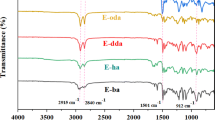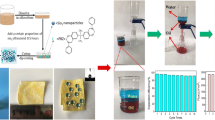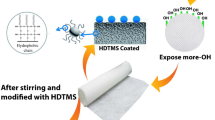Abstract
In the present work, the surface behavior of cotton fabrics coated with a series of bio-based polybenzoxazines is explored. Herein, we report the design and synthesis of bio-based benzoxazine monomers (C-x) using cardanol (C) and seven different amines (x = ba, ha, dda, oda, ddm, jef, and fa). The molecular structures of the benzoxazine monomers have been confirmed using FTIR and NMR analyses. The microstructure of the polybenzoxazine-coated cotton fabrics observed from FE-SEM reveals that formation of rough nanostructure is influenced by molecular structure of monomers. Further, surface analysis shows that poly(C-dda)-coated cotton fabric offers superior water contact angle (WCA = 155° ± 3) with low sliding angle (6°). Also, poly(C-dda)-coated cotton fabric delivers the lowest surface energy (14.1 mN/m) and high resistance against acidic and alkaline media. Subsequently, oil–water separation investigation shows that the poly(C-dda)-coated cotton fabric yields 99% of separation efficiency with flux value of 7200 L/m2h. Thus, the cardanol-based polybenzoxazine-coated cotton fabrics prepared in the present work can find application in the field of oil–water separation due to their superior water-repellent nature.














Similar content being viewed by others
References
Sasaki, K, Tenjimbayashi, M, Manabe, K, Shiratori, S, “Asymmetric Superhydrophobic/Superhydrophilic Cotton Fabrics Designed by Spraying Polymer and Nanoparticles.” ACS Appl. Mater. Interfaces, 8 651–659 (2016)
Lahiri, SK, Zhang, P, Zhang, C, Liu, L, “Robust Fluorine-Free and Self-Healing Superhydrophobic Coatings by H3BO3 Incorporation with SiO2-Alkyl-Silane@PDMS on Cotton Fabric.” ACS Appl. Mater. Interfaces, 11 10262–10275 (2019)
Ge, M, Cao, C, Liang, F, Liu, R, Zhang, Y, Zhang, W, Zhu, T, Yi, B, Tang, Y, Lai, Y, “A “PDMS-in-Water” Emulsion Enables Mechanochemically Robust Superhydrophobic Surfaces with Self-healing Nature.” Nanoscale Horiz., 5 65–73 (2020)
Dong, X, Gao, S, Huang, J, Li, S, Zhu, T, Cheng, Y, Zhao, Y, Chen, Z, Lai, Y, “A Self-roughened and Biodegradable Superhydrophobic Coating with UV Shielding, Solar-induced Self-healing and Versatile Oil-Water Separation Ability.” J. Mater. Chem. A., 7 2122–2128 (2019)
Gao, S, Dong, X, Huang, J, Li, S, Li, Y, Chen, Z, Lai, Y, “Rational Construction of Highly Transparent Superhydrophobic Coatings Based on a Non-particle, Fluorine-Free and Water-Rich System for Versatile Oil-Water Separation.” Chem. Eng. J., 333 621–629 (2018)
Bhushan, B, “Bioinspired Oil-Water Separation Approaches for Oil Spill Clean-up and Water Purification.” Philos. Trans. R. Soc. A Math. Phys. Eng. Sci., 377 20190120 (2019)
Xue, Z, Wang, S, Lin, L, Chen, L, Liu, M, Feng, L, Jiang, L, “A Novel Superhydrophilic and Underwater Superoleophobic Hydrogel-Coated Mesh for Oil/Water Separation.” Adv. Mater., 23 4270–4273 (2011)
Xue, Z, Cao, Y, Liu, N, Feng, L, Jiang, L, “Special Wettable Materials for Oil/Water Separation.” J. Mater. Chem. A., 2 2445–2460 (2014)
Wang, CF, Wang, YT, Tung, PH, Kuo, SW, Lin, CH, Sheen, YC, Chang, FC, “Stable Superhydrophobic Polybenzoxazine Surfaces over a Wide pH Range.” Langmuir, 22 8289–8292 (2006)
Rajamanikam, R, Pichaimani, P, Kumar, M, Muthukaruppan, A, “Optical and Thermomechanical Behavior of Benzoxazine Functionalized ZnO Reinforced Polybenzoxazine Nanocomposites.” Polym. Compos., 3 1881–1889 (2017)
Zhang, W, Lu, X, Xin, Z, Zhou, C, “Development of a Superhydrophobic Polybenzoxazine Surface with Self-cleaning and Reversible Water Adhesion Properties.” RSC Adv., 6 106054–106063 (2016)
Wang, CF, Su, YC, Kuo, SW, Huang, CF, Sheen, YC, Chang, FC, “Low-Surface-Free-Energy Materials Based on Polybenzoxazines.” Angew. Chem. Int. Ed., 45 2248–2251 (2006)
Revathi, R, Prabunathan, P, Kumar, M, Alagar, M, “Studies on Graphene Oxide–Reinforced Polybenzoxazine Nanocomposites.” High Perform. Polym., 28 425–435 (2016)
Gogoi, N, Rastogi, D, Jassal, M, Agrawal, AK, “Low-Surface-Energy Materials Based on Polybenzoxazines for Surface Modification of Textiles.” J. Text Inst., 105 1212–1220 (2014)
Zhang, T, Yan, H, Fang, Z, Yuping, E, Wu, T, Chen, F, “Superhydrophobic and Conductive Properties of Carbon Nanotubes/Polybenzoxazine Nanocomposites Coated Ramie Fabric Prepared by Solution-Immersion Process.” Appl. Surf. Sci., 309 218–224 (2014)
Zhang, W, Lu, X, Xin, Z, Zhou, C, “A Self-cleaning Polybenzoxazine/TiO2 Surface with Superhydrophobicity and Superoleophilicity for Oil/Water Separation.” Nanoscale, 7 (46) 19476–19483 (2015)
Caldona, EB, De Leon, ACC, Thomas, PG, Naylor, DF, Pajarito, BB, Advincula, RC, “Superhydrophobic Rubber-Modified Polybenzoxazine/SiO2 Nanocomposite Coating with Anticorrosion, Anti-Ice, and Superoleophilicity Properties.” Ind. Eng. Chem. Res., 56 1485–1497 (2017)
Li, Y, Yu, Q, Yin, X, Xu, J, Cai, Y, Han, L, Huang, H, Zhou, Y, Tan, Y, Wang, L, Wang, H, “Fabrication of Superhydrophobic and Superoleophilic Polybenzoxazine-Based Cotton Fabric for Oil–Water Separation.” Cellulose, 25 6691–6704 (2018)
Lehmler, HJ, Liu, B, Gadogbe, M, Bao, W, “Exposure to Bisphenol A, Bisphenol F, and Bisphenol S in U.S. Adults and Children: The National Health and Nutrition Examination Survey 2013–2014.” ACS Omega, 3 6523–6532 (2018)
Okada, H, Tokunaga, T, Liu, X, Takayanagi, S, Matsushima, A, Shimohigashi, Y, “Direct Evidence Revealing Structural Elements Essential for the High Binding Ability of Bisphenol A to Human Estrogen-Related Receptor-γ.” Environ. Health Perspect., 116 32–38 (2008)
Manoj, M, Kumaravel, A, Mangalam, R, Prabunathan, P, Hariharan, A, Alagar, M, “Exploration of High Corrosion Resistance Property of Less Hazardous Pyrazolidine-Based Benzoxazines in Comparison with Bisphenol-F Derivatives.” J. Coat. Technol. Res., (2020). https://doi.org/10.1007/s11998-019-00312-4
Hariharan, A, Prabunathan, P, Kumaravel, A, Manoj, M, Alagar, M, “Bio-Based Polybenzoxazine Composites for Oil-Water Separation, Sound Absorption and Corrosion Resistance Applications.” Polym. Test., 86 106443 (2020)
Hariharan, A, Prabunathan, P, Subramanian, SS, Kumaravel, M, Alagar, M, “Blends of Chalcone Benzoxazine and Bio-benzoxazines Coated Cotton Fabrics for Oil-Water Separation and Bio-silica Reinforced Nanocomposites for Low-k Applications.” J. Polym. Environ., 28 598–613 (2020)
Prabunathan, P, Vasanthakumar, A, Manoj, M, Hariharan, A, Alagar, M, “Polypyrrole Inter-layered Low Temperature Curing Benzoxazine Matrices with Enhanced Thermal and Dielectric Properties.” J. Polym. Res., 27 1–14 (2020)
Prabunathan, P, Thennarasu, P, Song, JK, Alagar, M, “Achieving Low Dielectric, Surface Free Energy and UV Shielding Green Nanocomposites via Reinforcing Bio-silica Aerogel with Polybenzoxazine.” New J. Chem., 41 5313–5321 (2017)
Yao, H, Lu, X, Xin, Z, Zhang, H, Li, X, “A Durable Bio-based Polybenzoxazine/SiO2 Modified Fabric with Superhydrophobicity and Superoleophilicity for Oil/Water Separation.” Sep. Purif. Technol., 229 115792 (2019)
Rao, BS, Palanisamy, A, “Monofunctional Benzoxazine from Cardanol for Bio-composite Applications.” React. Funct. Polym., 71 148–154 (2011)
Lu, R, Gan, W, Wu, BH, Zhang, Z, Guo, Y, Wang, HF, “C-H Stretching Vibrations of Methyl, Methylene and Methine Groups at the Vapor/Alcohol (n = 1–8) Interfaces.” J. Phys. Chem. B, 109 14118–14129 (2005)
Rao, BS, Palanisamy, A, “A New Thermo Set System Based on Cardanol Benzoxazine and Hydroxy Benzoxazoline with Lower Cure Temperature.” Prog. Org. Coat., 74 427–434 (2012)
Parveen, AS, Thirukumaran, P, Sarojadevi, M, “Low Dielectric Materials from Fluorinated Polybenzoxazines.” Polym. Adv. Technol., 25 1538–1545 (2014)
Bonnaud, L, Chollet, B, Dumas, L, Peru, AA, Flourat, AL, Allais, F, Dubois, P, “High-Performance Bio-Based Benzoxazines from Enzymatic Synthesis of Diphenols.” Macromol. Chem. Phys., 220 1800312 (2019)
Zhang, T, Wang, J, Feng, T, Wang, H, Ramdani, N, Derradji, M, Xu, X, Liu, W, Tang, T, “A Novel High Performance Oxazine Derivative: Design of Tetrafunctional Monomer, Step-wise Ring-opening Polymerization, Improved Thermal Property and Broadened Processing Window.” RSC Adv., 5 33623–33631 (2015)
Lin, RC, Kuo, SW, “Well-defined Benzoxazine/Triphenylamine-Based Hyperbranched Polymers with Controlled Degree of Branching.” RSC Adv., 8 13592–13611 (2018)
Manickam, M, Pichaimani, P, Arumugam, H, Muthukaruppan, A, “Synthesis of Nontoxic Pyrazolidine-Based Benzoxazine-Coated Cotton Fabric for Oil-Water Separation.” Ind. Eng, Chem. Res., 58 21419–21430 (2020)
Shukla, S, Lochab, B, “Role of Higher Aromatic Content in Modulating Properties of Cardanol Based Benzoxazines.” Polymer (Guildf), 99 684–694 (2016)
Rao, BS, Surendra, P, “Synthesis and Characterization of Difunctional Benzoxazines from Aromatic Diester Diamine Containing Varying Length of Aliphatic Spacer Group: Polymerization, Thermal and Viscoelastic Characteristics.” Eur. Polym. J., 77 139–154 (2016)
Allen, DJ, Ishida, H, “Polymerization of Linear Aliphatic Diamine-Based Benzoxazine Resins Under Inert and Oxidative Environments.” Polymer (Guildf), 48 6763–6772 (2007)
Thennarasu, P, Prabunathan, P, Senthilkumar, M, “Development of Biomass-Derived Functionalized Activated Carbon-Coated and Polyaniline-Grafted Cotton Fabric with Enhanced Ultraviolet Resistance.” J. Ind. Text., 47 1609–1625 (2018)
Basak, S, Samanta, KK, Chattopadhyay, SK, “Fire Retardant Property of Cotton Fabric Treated with Herbal Extract.” J. Text. Inst., 106 1338–1347 (2015)
Balachandran, VS, Jadhav, SR, Vemula, PK, John, G, “Recent Advances in Cardanol Chemistry in a Nutshell: From a Nut to Nanomaterials.” Chem. Soc. Rev., 42 427–438 (2013)
Arumugam, H, Krishnan, S, Chavali, M, Muthukaruppan, A, “Cardanol Based Benzoxazine Blends and Bio-silica Reinforced Composites: Thermal and Dielectric Properties.” New J. Chem., 42 4067–4080 (2018)
Cheng, M, He, H, Zhu, H, Guo, W, Chen, W, Xue, F, Zhou, S, Chen, X, Wang, S, “Preparation and Properties of pH-Responsive Reversible-Wettability Biomass Cellulose-Based Material for Controllable Oil/Water Separation.” Carbohydr. Polym., 203 246–255 (2019)
Jeevahan, J, Chandrasekaran, M, Britto Joseph, G, Durairaj, RB, Mageshwaran, G, “Superhydrophobic Surfaces: A Review on Fundamentals, Applications, and Challenges.” J. Coat. Technol. Res., 15 231–250 (2018)
Jin, M, Li, S, Wang, J, Liao, M, Zhao, Y, “Controllable Fabrication of Organosilane Nano-architectured Surfaces with Tunable Wettability.” Appl. Surf. Sci., 258 7552–7555 (2012)
Reshmi, CR, Sundaran, SP, Juraij, A, Athiyanathil, S, “Fabrication of Superhydrophobic Polycaprolactone/Beeswax Electrospun Membranes for High-Efficiency Oil/Water Separation.” RSC Adv., 7 2092–2102 (2017)
Acknowledgments
The authors thank the DST-SERB (TAR/2019/000234), India, and the PSG Management for their financial and moral support. Also, the authors acknowledge the SIF, VIT-Vellore, for providing NMR facility and CLIF, University of Kerala, for providing XPS facility. In addition, the authors acknowledge Mr. M. Venkatesan, SIF, VIT, for his continuous support.
Author information
Authors and Affiliations
Corresponding authors
Ethics declarations
Conflict of interest
There are no conflicts to declare.
Additional information
Publisher's Note
Springer Nature remains neutral with regard to jurisdictional claims in published maps and institutional affiliations.
Electronic supplementary material
Below is the link to the electronic supplementary material.
Supplementary material 2 (MP4 122323 kb)
Supplementary material 3 (MP4 79158 kb)
Rights and permissions
About this article
Cite this article
Prabunathan, P., Elumalai, P., Dinesh Kumar, G. et al. Antiwetting and low-surface-energy behavior of cardanol-based polybenzoxazine-coated cotton fabrics for oil–water separation. J Coat Technol Res 17, 1455–1469 (2020). https://doi.org/10.1007/s11998-020-00365-w
Published:
Issue Date:
DOI: https://doi.org/10.1007/s11998-020-00365-w




